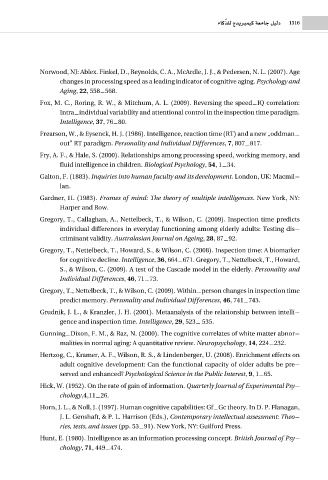Page 1317 - theCambridgehandbookofintelligence1
P. 1317
AÉcòs ∏d êójôѪ«c á©eÉL π«dO 1316
Norwood, NJ: Ablex. Finkel, D., Reynolds, C. A., McArdle, J. J., & Pedersen, N. L. (2007). Age
changes in processing speed as a leading indicator of cognitive aging. Psychology and
Aging, 22, 558-568.
Fox, M. C., Roring, R. W., & Mitchum, A. L. (2009). Reversing the speed-IQ correlation:
Intra-individual variability and attentional control in the inspection time paradigm.
Intelligence, 37, 76-80.
Frearson, W., & Eysenck, H. J. (1986). Intelligence, reaction time (RT) and a new „oddman-
out RT paradigm. Personality and Individual Differences, 7, 807-817.
Fry, A. F., & Hale, S. (2000). Relationships among processing speed, working memory, and
fluid intelligence in children. Biological Psychology, 54, 1-34.
Galton, F. (1883). Inquiries into human faculty and its development. London, UK: Macmil-
lan.
Gardner, H. (1983). Frames of mind: The theory of multiple intelligences. New York, NY:
Harper and Row.
Gregory, T., Callaghan, A., Nettelbeck, T., & Wilson, C. (2009). Inspection time predicts
individual differences in everyday functioning among elderly adults: Testing dis-
criminant validity. Australasian Journal on Ageing, 28, 87-92.
Gregory, T., Nettelbeck, T., Howard, S., & Wilson, C. (2008). Inspection time: A biomarker
for cognitive decline. Intelligence, 36, 664-671. Gregory, T., Nettelbeck, T., Howard,
S., & Wilson, C. (2009). A test of the Cascade model in the elderly. Personality and
Individual Differences, 46, 71-73.
Gregory, T., Nettelbeck, T., & Wilson, C. (2009). Within-person changes in inspection time
predict memory. Personality and Individual Differences, 46, 741-743.
Grudnik, J. L., & Kranzler, J. H. (2001). Metaanalysis of the relationship between intelli-
gence and inspection time. Intelligence, 29, 523- 535.
Gunning-Dixon, F. M., & Raz, N. (2000). The cognitive correlates of white matter abnor-
malities in normal aging: A quantitative review. Neuropsychology, 14, 224-232.
Hertzog, C., Kramer, A. F., Wilson, R. S., & Lindenberger, U. (2008). Enrichment effects on
adult cognitive development: Can the functional capacity of older adults be pre-
served and enhanced? Psychological Science in the Public Interest, 9, 1-65.
Hick, W. (1952). On the rate of gain of information. Quarterly Journal of Experimental Psy-
chology,4,11-26.
Horn, J. L., & Noll, J. (1997). Human cognitive capabilities: Gf-Gc theory. In D. P. Flanagan,
J. L. Genshaft, & P. L. Harrison (Eds.), Contemporary intellectual assessment: Theo-
ries, tests, and issues (pp. 53-91). New York, NY: Guilford Press.
Hunt, E. (1980). Intelligence as an information processing concept. British Journal of Psy-
chology, 71, 449-474.

